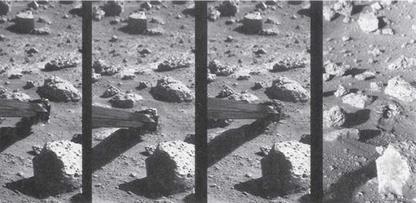Searching for Life
The grip that Mars holds on the popular imagination is grounded in the question of whether Mars ever was, or is, alive. The Viking landers were explicitly designed to search for evidence of life in the Martian regolith or perhaps in the planet’s geological past.41
|
Figure 2.3. The Viking 2 landing site, named by NASA the Gerald Soffen Memorial Station, as seen in a mosaic of images from the lander. The sequence shows the robotic arm extending out to scoop a small amount of the Martian rego – lith, then retracting to deposit the sample in one of the biological experiments onboard (NASA/Viking Lander Image Archive). |
The short section of the mission science summary on life detection is worth quoting in full because of the surprising ambiguity of the wording: “Three experiments were conducted to test directly for life on Mars. The tests revealed a surprisingly chemically active surface—very likely oxidizing. All experiments yielded results, but these are subject to wide interpretation. No conclusions were reached concerning the existence of life on Mars.”42
The Viking landers packed a substantial scientific punch in their 200-pound payloads. Power came from a plutonium-238 radioisotope thermal generator, eking out 30 Watts of continuous power. Using late 1970s technology, Viking’s data capabilities were even more feeble; the data recorder on each lander could only store 8 Mbytes at a time, thousands of times less than the average memory stick. The landers had cameras that could take 360-degree panoramic images. They had seismometers and instruments to test magnetic fields. They had meteorology booms that measured temperature, pressure, and wind speed and direction. Most importantly, they had robotic arms that could scoop up soil samples and deposit them into temperature-controlled and sealed containers on each spacecraft (figure 2.3).
The biological package contained four instruments. A gas chromatograph and mass spectrometer heated soil samples and measured the molecular weight of each component of the vapor released, down to a concentration of a few parts per billion. The instrument found no significant levels of organic, or carbon-based, molecules. Mars soil had even less carbon than the lifeless soils tested on the Moon by the Apollo missions. This seemed to be prima facie evidence against life. The gas exchange instrument added nutrients, and then water, to a soil sample, and then looked for changes in the concentration of gases such as oxygen and methane in the sealed chamber. The hypothesis was that a living organism would process one of the gases. The result was negative. The pyrolytic release experiment created an “atmosphere” in the chamber using radioactive carbon, in the hope that a photosynthetic organism would incorporate the carbon the way plants do on Earth. After several days of incubation under an artificial Sun (in this case, a xenon arc lamp), the sample was baked at a high temperature to see if any of the radioactive carbon had been converted into biomass. The results were also negative.43
The only wild card was the labeled release experiment. A sample of soil had nutrients dissolved in water added to it, and the nutrients were “tagged” with radioactive carbon, which was once again used as a tracer. To the surprise of the instrument team, radioactive carbon dioxide was detected in the air above the samples, suggesting that microbes had metabolized one or more of the ingredients. The same result was seen in both Viking landers. However, when the experiment was repeated a week later, the air was free of radioactive carbon. The data were declared inconclusive.44
Overall, the results were disheartening for those who hoped that Mars might be a living world. Terrestrial life is based on complex molecules with a carbon backbone—organic ingredients like carbohydrates, proteins, nucleic acids, and lipids. While organic does not mean biological, all life on Earth is carbon-based and so is made of organic ingredients. The Viking experiments detected virtually no organic compounds in the Martian regolith. This was somewhat surprising, since they are fairly common on small Solar System bodies like comets, asteroids, and meteorites. With no organic material, the biological experiments would have been doomed to failure, since their aim was to detect a metabolism that could incorporate carbon from the atmosphere, as microbes on Earth do. The lander could only gather samples from the top few centimeters of the regolith, and that layer is blasted with ultraviolet radiation and cosmic rays from space (Mars has no protective layer of ozone). The surface is strongly oxidizing, as the “rusty” red color of iron oxide indicates.45 So the conventional interpretation is that activity seen in the experiments was caused by chemical reactions involving oxidizing molecules in the soil, with no biological explanation required.











